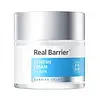What's inside
What's inside
 Key Ingredients
Key Ingredients

 Benefits
Benefits

 Concerns
Concerns

 Ingredients Side-by-side
Ingredients Side-by-side

Water
Skin ConditioningButyrospermum Parkii Butter
Skin ConditioningCaprylic/Capric Triglyceride
MaskingGlycerin
HumectantPentylene Glycol
Skin ConditioningBeeswax
Emulsion StabilisingGlyceryl Stearate
EmollientCetearyl Olivate
Centella Asiatica Extract
CleansingSorbitan Olivate
EmulsifyingCetearyl Alcohol
EmollientArachidyl Alcohol
EmollientAdansonia Digitata Seed Oil
EmollientCetyl Alcohol
EmollientBehenyl Alcohol
EmollientHippophae Rhamnoides Fruit Extract
Skin ConditioningHydrogenated Lecithin
EmulsifyingArachidyl Glucoside
EmulsifyingSodium Phytate
Glucose
HumectantCitric Acid
BufferingRosmarinus Officinalis Leaf Extract
AntimicrobialCeramide NP
Skin ConditioningPhytosphingosine
Skin ConditioningWater, Butyrospermum Parkii Butter, Caprylic/Capric Triglyceride, Glycerin, Pentylene Glycol, Beeswax, Glyceryl Stearate, Cetearyl Olivate, Centella Asiatica Extract, Sorbitan Olivate, Cetearyl Alcohol, Arachidyl Alcohol, Adansonia Digitata Seed Oil, Cetyl Alcohol, Behenyl Alcohol, Hippophae Rhamnoides Fruit Extract, Hydrogenated Lecithin, Arachidyl Glucoside, Sodium Phytate, Glucose, Citric Acid, Rosmarinus Officinalis Leaf Extract, Ceramide NP, Phytosphingosine
Water
Skin ConditioningCaprylic/Capric Triglyceride
MaskingButylene Glycol
HumectantGlycerin
HumectantCetearyl Alcohol
EmollientPropanediol
SolventPanthenol
Skin ConditioningMyristoyl/Palmitoyl Oxostearamide/Arachamide Mea
Skin ConditioningGlyceryl Stearate
EmollientPolyglyceryl-10 Distearate
EmulsifyingDimethicone
EmollientSorbitan Stearate
EmulsifyingViscum Album Fruit Extract
Soothing1,2-Hexanediol
Skin ConditioningLimnanthes Alba Seed Oil
Skin ConditioningOlea Europaea Fruit Oil
MaskingHydrogenated Vegetable Oil
EmollientXylitylglucoside
HumectantAnhydroxylitol
HumectantXylitol
HumectantGlucose
HumectantTocopheryl Acetate
AntioxidantPhytosterols
Skin ConditioningPhospholipids
Skin ConditioningDihydroxyisopropyl Palmoylpalmamide
HumectantBis-Capryloyloxypalmitamido Isopropanol
EmollientAllantoin
Skin ConditioningAcetyl Heptapeptide-4
HumectantHelianthus Annuus Seed Oil
EmollientSalvia Officinalis Oil
MaskingPogostemon Cablin Leaf Oil
MaskingElettaria Cardamomum Seed Oil
MaskingMentha Arvensis Leaf Oil
MaskingChamomilla Recutita Flower Oil
MaskingJuniperus Mexicana Oil
MaskingBiosaccharide Gum-1
HumectantSodium Hyaluronate
HumectantAcetyl Dipeptide-1 Cetyl Ester
Skin ConditioningMadecassoside
AntioxidantStearic Acid
CleansingCarbomer
Emulsion StabilisingCaprylyl Glycol
EmollientWater, Caprylic/Capric Triglyceride, Butylene Glycol, Glycerin, Cetearyl Alcohol, Propanediol, Panthenol, Myristoyl/Palmitoyl Oxostearamide/Arachamide Mea, Glyceryl Stearate, Polyglyceryl-10 Distearate, Dimethicone, Sorbitan Stearate, Viscum Album Fruit Extract, 1,2-Hexanediol, Limnanthes Alba Seed Oil, Olea Europaea Fruit Oil, Hydrogenated Vegetable Oil, Xylitylglucoside, Anhydroxylitol, Xylitol, Glucose, Tocopheryl Acetate, Phytosterols, Phospholipids, Dihydroxyisopropyl Palmoylpalmamide, Bis-Capryloyloxypalmitamido Isopropanol, Allantoin, Acetyl Heptapeptide-4, Helianthus Annuus Seed Oil, Salvia Officinalis Oil, Pogostemon Cablin Leaf Oil, Elettaria Cardamomum Seed Oil, Mentha Arvensis Leaf Oil, Chamomilla Recutita Flower Oil, Juniperus Mexicana Oil, Biosaccharide Gum-1, Sodium Hyaluronate, Acetyl Dipeptide-1 Cetyl Ester, Madecassoside, Stearic Acid, Carbomer, Caprylyl Glycol
 Reviews
Reviews

Ingredients Explained
These ingredients are found in both products.
Ingredients higher up in an ingredient list are typically present in a larger amount.
This ingredient is an emollient, solvent, and texture enhancer. It is considered a skin-softener by helping the skin prevent moisture loss.
It helps thicken a product's formula and makes it easier to spread by dissolving clumping compounds.
Caprylic Triglyceride is made by combining glycerin with coconut oil, forming a clear liquid.
While there is an assumption Caprylic Triglyceride can clog pores due to it being derived from coconut oil, there is no research supporting this.
Learn more about Caprylic/Capric TriglycerideCetearyl alcohol is a mixture of two fatty alcohols: cetyl alcohol and stearyl alcohol. It is mainly used as an emulsifier. Emulsifiers help prevent the separation of oils and products. Due to its composition, it can also be used to thicken a product or help create foam.
Cetearyl alcohol is an emollient. Emollients help soothe and hydrate the skin by trapping moisture.
Studies show Cetearyl alcohol is non-toxic and non-irritating. The FDA allows products labeled "alcohol-free" to have fatty alcohols.
This ingredient is usually derived from plant oils such as palm, vegetable, or coconut oils. There is debate on whether this ingredient will cause acne.
Due to the fatty acid base, this ingredient may not be Malassezia folliculitis safe.
Learn more about Cetearyl AlcoholGlucose is a simple sugar and is the most important source of energy in all organisms.
In skincare, glucose is used to hydrate the skin. It also acts as a prebiotic for our natural biome.
Glucose is hydrating due to its humectant property. As a humectant, glucose draws moisture from the air and from deeper levels in the skin.
Our skin contains many sugars that act as prebiotics and help strengthen our natural microbiome. Having a healthy microbiome helps protect our skin from harmful bacteria and other contaminants.
Studies show glucose may help with fading discoloration and pigmentation. This is because our skin metabolizes glucose into lactic acid. Lactic acid is an AHA that helps exfoliate the top layer of skin.
Learn more about GlucoseGlycerin is already naturally found in your skin. It helps moisturize and protect your skin.
A study from 2016 found glycerin to be more effective as a humectant than AHAs and hyaluronic acid.
As a humectant, it helps the skin stay hydrated by pulling moisture to your skin. The low molecular weight of glycerin allows it to pull moisture into the deeper layers of your skin.
Hydrated skin improves your skin barrier; Your skin barrier helps protect against irritants and bacteria.
Glycerin has also been found to have antimicrobial and antiviral properties. Due to these properties, glycerin is often used in wound and burn treatments.
In cosmetics, glycerin is usually derived from plants such as soybean or palm. However, it can also be sourced from animals, such as tallow or animal fat.
This ingredient is organic, colorless, odorless, and non-toxic.
Glycerin is the name for this ingredient in American English. British English uses Glycerol/Glycerine.
Learn more about GlycerinGlyceryl Stearate is a mix of glycerin and stearic acid.
It is used to stabilize the mixing of water and oil ingredients. By preventing these ingredients from separating, it can help elongate shelf life. It can also help thicken the product's texture.
As an emollient, it helps soften skin and supports barrier-replenishing ingredients.
In cosmetics, Glyceryl Stearate is often made from vegetable oils or synthetically produced.
This ingredient may not be fungal-acne safe
Fun fact: The human body also creates Glyceryl Stearate naturally.
Learn more about Glyceryl StearateWater. It's the most common cosmetic ingredient of all. You'll usually see it at the top of ingredient lists, meaning that it makes up the largest part of the product.
So why is it so popular? Water most often acts as a solvent - this means that it helps dissolve other ingredients into the formulation.
You'll also recognize water as that liquid we all need to stay alive. If you see this, drink a glass of water. Stay hydrated!
Learn more about Water